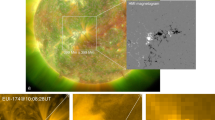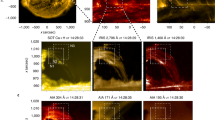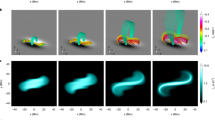Abstract
It is now apparent that there are at least two heating mechanisms in the Sun’s outer atmosphere, or corona1,2,3,4,5. Wave heating may be the prevalent mechanism in quiet solar periods and may contribute to heating the corona to 1,500,000 K (refs 1, 2, 3). The active corona needs additional heating to reach 2,000,000–4,000,000 K; this heat has been theoretically proposed6,7,8,9,10,11,12 to come from the reconnection and unravelling of magnetic ‘braids’. Evidence favouring that process has been inferred13,14, but has not been generally accepted because observations are sparse and, in general, the braided magnetic strands that are thought1,2,3,15,16,17 to have an angular width of about 0.2 arc seconds have not been resolved10,18,19,20. Fine-scale braiding has been seen21,22 in the chromosphere but not, until now, in the corona. Here we report observations, at a resolution of 0.2 arc seconds, of magnetic braids in a coronal active region that are reconnecting, relaxing and dissipating sufficient energy to heat the structures to about 4,000,000 K. Although our 5-minute observations cannot unambiguously identify the field reconnection and subsequent relaxation as the dominant heating mechanism throughout active regions, the energy available from the observed field relaxation in our example is ample for the observed heating.
This is a preview of subscription content, access via your institution
Access options
Subscribe to this journal
Receive 51 print issues and online access
$199.00 per year
only $3.90 per issue
Buy this article
- Purchase on Springer Link
- Instant access to full article PDF
Prices may be subject to local taxes which are calculated during checkout




Similar content being viewed by others
References
Wedemeyer-Böhm, S. et al. Magnetic tornadoes as energy channels into the solar corona. Nature 486, 505–508 (2012)
McIntosh, S. et al. Alfvenic waves with sufficient energy to power the quiet solar corona and fast solar wind. Nature 475, 477–480 (2011)
De Pontieu, B. et al. Chromospheric Alfevic waves strong enough to power the solar wind. Science 318, 1574–1577 (2007)
Cirtain, J. et al. Evidence for Alfven waves in solar X-ray jets. Science 318, 1580–1582 (2007)
Priest, E. et al. Nature of the heating mechanism for the diffuse solar corona. Nature 393, 545–547 (1998)
Parker, E. Magnetic neutral sheets in evolving fields. I. General Theory. Astrophys. J. 264, 635–641 (1983)
Parker, E. Magnetic neutral sheets in evolving fields. II. Formation of the solar corona. Astrophys. J. 264, 642–647 (1983)
Schrijver, K. Braiding-induced interchange reconnection of the magnetic field and the width of solar coronal loops. Astrophys. J. 662, L119–L122 (2007)
Gudiksen, B. V. & Nordlund, Å. An ab initio approach to the solar coronal heating problem. Astrophys. J. 618, 1020–1030 (2005)
Klimchuk, J. On solving the coronal heating problem. Sol. Phys. 234, 41–77 (2006)
Gold, T. in Stellar and Solar Magnetic Fields (ed. Lüst, R. ) 390–398 (Proc. IAU Symp. 22, International Astronomical Union, 1965)
Warren, H. P., Winebarger, A. R. & Hamilton, P. S. Hydrodynamic modeling of active region loops. Astrophys. J. 579, L41–L44 (2002)
Schrijver, K. et al. Large-scale coronal heating by the small-scale magnetic field of the Sun. Nature 394, 152–154 (1998)
Lee, J. et al. Coronal currents, magnetic fields, and heating in a solar active region. Astrophys. J. 501, 853–865 (1998)
De Pontieu, B. et al. Observing solar coronal heating-in the chromosphere. Astrophys. J. 701, L1–L6 (2009)
De Pontieu, B. et al. The origins of hot plasma in the solar corona. Science 331, 55–58 (2011)
DeForest, C. E. On the size of structures in the corona. Astrophys. J. 661, 532–542 (2007)
Berger, M. &. Asgari-Targhi, M. Self-organized braiding and the structure of coronal loops. Astrophys. J. 705, 347–355 (2009)
van Ballegooijen, A. Heating of the solar chromosphere and corona by Alfven wave turbulence. Astrophys. J. 736, 3–9 (2011)
Malanushenko, A., Yusuf, M. H. & Longcope, D. Direct measurements of magnetic twist in the solar corona. Astrophys. J. 736, 97–109 (2011)
Rutten, R. Hα as chromospheric diagnostic. ASP Conf. Ser. 397, 54–58 (2008)
Martin, S. Conditions for the formation and maintenance of filaments. Sol. Phys. 182, 107–137 (1998)
Lemen, J. R. et al. The Atmospheric Imaging Assembly (AIA) on the Solar Dynamics Observatory (SDO). Sol. Phys. 275, 17–40 (2012)
Culhane, L. et al. The EUV imaging spectrometer for Hinode. Sol. Phys. 243, 19–61 (2007)
Acknowledgements
We thank the NASA Low-Cost Access to Space programme for supporting the development of the Hi-C instrument, the NASA Sounding Rocket Office for the launch of the instrument and the NASA Marshall Space Flight Center for instrument development support. This LPI work was supported in part by the Russian Foundation for Basic Research (project 11–02–01079-a), Program No. 22 of the Presidium of the Russian Academy of Sciences.
Author information
Authors and Affiliations
Contributions
J.W.C., A.R.W., B.D.P., P.M. and C.E.D. performed image processing and analysis of observations. M.W., K.K., B.D.P., C.E.D. and A.R.W. all contributed to the calibration and alignment of the instrument and science data. J.W.C., L.G., K.K. and K.E.K. managed the design, construction and testing of the experiment. J.W.C. and A.R.W. determined velocities and J.W.C and R.L.M. calculated the stored energy. A.T., R.W.W. and S.K. contributed to the instrumentation.
Corresponding author
Ethics declarations
Competing interests
The authors declare no competing financial interests.
Supplementary information
Supplementary Info
DESCRIPTION (PDF 2220 kb)
Experiment regions of interest
This video shows the full sun AIA images taken during the Hi-C flight. It zooms into the Hi-C field of full field of view and extracts the two examples from the paper, and shows comparison movies for AIA and Hi-C. The first comparison is for example 1 shown in Fig 2 and Supplementary Fig. 2 and Supplementary Video 2. The second comparison is for example 2 and goes with Fig. 3 and Supplementary Videos 3 & 4. (MOV 4672 kb)
Evolution of loops during component reconnection
This video presents the evolution of a set of loops that are interacting and wrapped together. As the structures evolve, reconnection allows the loops to relax into a less curved and thus more potential geometry. (MOV 4160 kb)
Evolution in a Braided Loop Ensemble
This braided loop has several loops near the 'base' that appear to be unwinding with significant apparent outflow. This is evidence of untwisting, and the braided structure also seeming to unwind with time. (MOV 5888 kb)
The Temperature history of the Braided Structure
Within the braided bundle, several episodic intensity increases are observed in many of the AIA passbands. This is direct evidence of impulsive energy release likely the result of reconnection. The process is observed many times in the AIA data over a long period of observations leading to the conclusion that the region is constantly being sheared, thus storing energy, and frequently releases some of this energy in these localized heating events. (MOV 1664 kb)
Rights and permissions
About this article
Cite this article
Cirtain, J., Golub, L., Winebarger, A. et al. Energy release in the solar corona from spatially resolved magnetic braids. Nature 493, 501–503 (2013). https://doi.org/10.1038/nature11772
Received:
Accepted:
Published:
Issue Date:
DOI: https://doi.org/10.1038/nature11772
This article is cited by
-
Generation of laboratory nanoflares from multiple braided plasma loops
Nature Astronomy (2023)
-
Ultra-high-resolution observations of persistent null-point reconnection in the solar corona
Nature Communications (2023)
-
Topologically protected vortex knots and links
Communications Physics (2022)
-
Novel Data Analysis Techniques in Coronal Seismology
Space Science Reviews (2022)
-
CASPER: A mission to study the time-dependent evolution of the magnetic solar chromosphere and transition regions
Experimental Astronomy (2022)
Comments
By submitting a comment you agree to abide by our Terms and Community Guidelines. If you find something abusive or that does not comply with our terms or guidelines please flag it as inappropriate.



